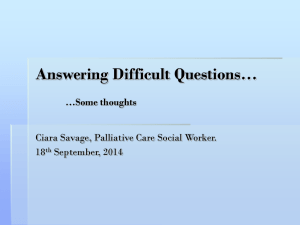PowerPoint **
advertisement
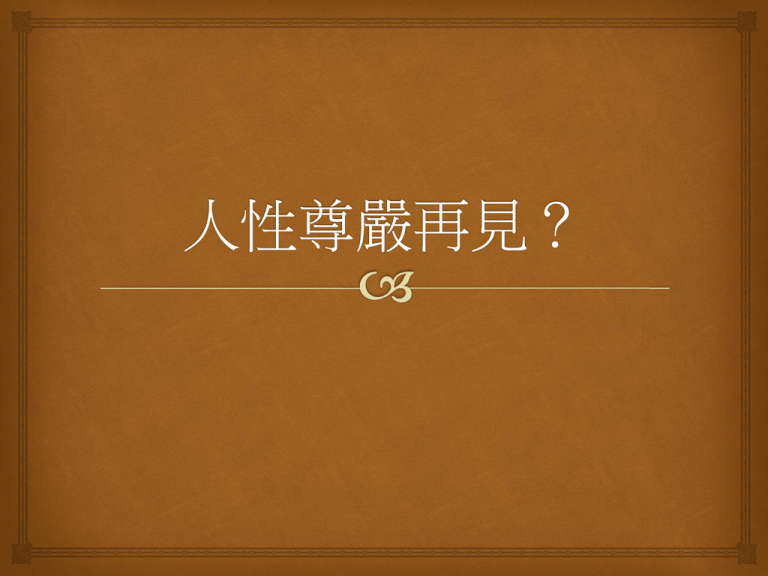
Human dignity Ever since 20th century, human dignity has been a term that figures frequently in all-important human rights documents, such as the Charter of the United Nations (1945) and the Universal Declaration of Human Rights (1948). The preamble to the Charter of the United Nations begins with: “We the people of the United Nations, determined to save succeeding generations from the scourge of war, which twice in our lifetime has brought untold sorrow to mankind, and to reaffirm faith in fundamental human rights, in the dignity and worth of the human person, in the rights of men and women and of nations large and small…” And in the Universal Declaration of Human Rights, one find the recognition “of the inherent dignity and of the equal and inalienable rights of all members of the human family.” And it is the same term that figures even more frequently in contemporary bioethical discussion of such issues as abortion, euthanasia, and human enhancement. Arguably, the idea of human dignity plays a significant role in philosophers’ deliberation about human rights and human life. The fact that human dignity, since 20th century, has been an oft-mentioned term in documents pertaining to human rights should not mislead us into thinking that it played an insignificant role in the traditional Western morality. Quite the reverse. According to Rachels [1990: 86], “the basic idea that forms the core of Western morals, and that is expressed, not only in philosophical writing, but in literature, religion, and in the common moral consciousness,” is the traditional idea of human dignity. Such a core idea, embraced by religious and secular thinkers alike, says that humans and non-human animals are in different moral categories, and that “the lives and interests of human beings are of supreme moral importance, while the lives and interests of other animals are relatively unimportant.” [171] 問題 日常生活中的哪些實作(practice)預設了人性尊嚴的 想法? The idea of human dignity What, exactly, is the traditional idea of human dignity? Human dignity, as the basic idea that forms the core of Western morals, has two parts, and involves a sharp contrast between human life and non-human life: (1) human life is regarded as sacred, or at least as having a special importance; and so, it is said, the central concern of our morality must be the protection and care of human beings. (2) non-human life does not have the same degree of moral protection. Indeed, on some traditional ways of thinking, non-human animals have no moral standing at all. Therefore, we may use them as we see fit. Western religious tradition According to the Western religious tradition, a blend of Judaism and Christianity, man was made in the image of God, with the world intended to be his habitation, and everything else in it given for his enjoyment and use. Throughout human history, God has continued to watch over and interact with man, communicating with him through the saints and prophets. One of the things he has communicated is a set of instructions telling us how we are to live; and almost all those instructions concern how we must treat other humans: our fellow humans are not to be killed, lied to, or otherwise mistreated. Their lives are sacred. Their needs are always to be taken into account, their rights always respected. The other animals were given by God for man’s use, to be worked, killed, and eaten at man’s pleasure. Like the rest of creation, they exist for man’s benefit. The ‘image of God’ thesis Man is special because he alone is made in the image of God, and above all other creatures he is the object of God’s love and attention; the other creatures, which were not made in God’s image, were given for man’s use. The matching moral idea is that human life is sacred, and the central concern of our morality must be the protection and care of human beings, whereas we may use the other creatures as we see fit. The secularization of man’s specialness doctrine If we are made in the image of God, it should be possible to identify the divine element in our makeup. But in what way, exactly, do we resemble the Almighty? According to the doctors of the Church, the divine element in man is his rationality. The rationality thesis Man is special because he alone is rational. Nonhuman animals are not rational, and so are not to be compared, in this regard, with humans. St. Thomas Aquinas: “Of all parts of the universe, intellectual creatures hold the highest place, because they approach nearest to the divine likeness. Therefore the divine providence provides for the intellectual nature for its own sake, and for all others for its sake.” The idea of a unique human mental capacity—a capacity unlike anything to be found elsewhere in nature—may therefore be viewed as the secular equivalent of the idea that man was created in the image of God. It does the same work in our moral system, namely, it buttresses the idea that, from a moral point of view, humans are special. This means that, even if the image of God thesis is rejected, the matching moral idea need not be abandoned. Secular thinkers who reject religion can continue to believe in human dignity, and can justify doing so by pointing to man’s unique rationality. Implications of the idea of human dignity The sanctity of innocent human life: such practices as suicide, euthanasia, and infanticide are violations of innocent life, and so they are not permitted. Suicide serves as a convenient example. One might think that, since the suicide takes only his or her own life, the prohibition upon it would not be so strict as the prohibition upon killing others. Prior to the coming of Christianity, the philosophers of Greece and Rome took this attitude. Although they condemned cowardly suicides, they thought it could be permissible in special circumstances. The Christians, however, took a sterner view. Augustine’s view on suicide St. Augustine: “Christians have no authority for committing suicide in any circumstances whatever.” Why? Argument: the sixth commandment says “Thou shalt not kill.” Augustine points out that the commandment does not say “Thou shalt not kill thy neighbor’; it says only “Thou shalt not kill”, point. Thus, the rule applies with equal force to killing oneself. Kant’s view on suicide Kant: humans have “an intrinsic worth, i.e., dignity”, which makes their value “above all price”. If human life has such extraordinary worth, then it is only to be expected that a man can never justify killing himself. Kant: people may offer various reasons to justify selfmurder, but these attempted justifications overlook the crucial point that “humanity is worthy of esteem.” Kant’s view on suicide To kill oneself is to regard one’s life as something of such little value that it can be obliterated merely in order to escape troubles. In the case of mere animals, this might be true—we kill animals to put them out of misery, and that is permissible. However, we should not think that the same may be done for a man, because the value of a man’s life is so much greater: “If [a man] disposes over himself, he treats his value as that of a beast.” Again, “the rule of morality does not admit of [suicide] under any condition because it degrades human nature below the level of animal nature and so destroys it.” Implications of the idea of human dignity The lesser status of non-human animals: the doctrine of man’s specialness serves to exalt man at the expense of the other creatures that inhabit the earth—we are morally special, and they are not. Because we have a different nature, we have a moral standing that they lack. Aquinas on the moral status of non-human animals Aquinas: although man’s rationality gives him a special status, other animals have a very different place in the natural order. “Other creatures are for the sake of the intellectual creatures.” Therefore, It is not wrong for man to make use of them, either by killing or in any other way whatever.” But shouldn’t we be kind to them out of simple charity? Aquinas: ”The love of charity extends to none but God and our neighbor. But the word neighbor cannot be extended to irrational creatures, since they have no fellowship with man in the rational life. Therefore charity does not extend to irrational creatures.” Kant on the moral status of nonhuman animals For Kant, non-human animals, lacking the all-important quality of rationality, are entirely excluded from the sphere of moral concern. It is man who is an ‘end in himself’. Other entities have value only as means, to serve that end. Thus, animals have the status of mere things, and we have no duties to them whatsoever: “so far as animals are concerned, we have no direct duties. Animals…are there merely as means to an end. That end is man.” By a ‘direct duty’ Kant meant a duty based on a concern for the animal’s own welfare. We may indeed have duties that involve animals, but the reason behind these duties will always refer to a human interest, rather than to the animal’s own interests. Kant adds that we should not torture animals pointlessly, but the reason, he insists, is only that “He who is cruel to animals becomes hard also in his dealings with men.” Is vs. Ought The image of God thesis and the rationality thesis are, speaking loosely, matters of fact. The matching moral idea is a normative view. What, exactly, is supposed to be the relation between them? It cannot be that the latter follows logically from the former, because, as Hume observed, normative conclusions cannot legitimately be derived form factual premises. What is the relation between the image of God thesis (or the rationality thesis) and the matching moral idea? It is not that the former is supposed to entail the latter. Rather, it is that the former is supposed to provide good reason for accepting the latter. In traditional morality, the doctrine of human dignity is not an arbitrary principle that hangs in logical space with no support. It is grounded in certain (alleged) facts about human nature; those facts are what (alleged) make it reasonable to believe in the moral doctrine. The claim implicit in traditional morality is that humans are morally special because they are made in the image of God, or because they are uniquely rational beings. How Darwinism might undermine traditional morality The claim that Darwinism undermines traditional morality is not the claim that it entails that the doctrine of human dignity is false. It is, instead, the claim that Darwinism provides reason for doubting the truth of the considerations that support the doctrine: form a Darwinian perspective, both the image of God thesis and the rationality thesis are suspect. Moreover, there are good Darwinian reasons for thinking it unlikely that any other support for human dignity can be found. Thus, Darwinism furnishes the ‘new information’ that undermines human dignity by taking away its support. Discussion Is Darwinism incompatible with the Image of God thesis, and the rationality thesis as well? Does Darwinism undermine the idea of human dignity? Can you find any other support for the idea of human dignity? Once the idea of human dignity is abandoned, is there any implication for our moral practice?

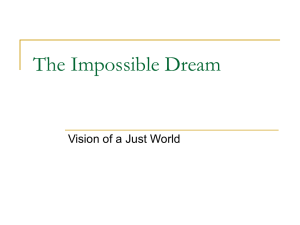
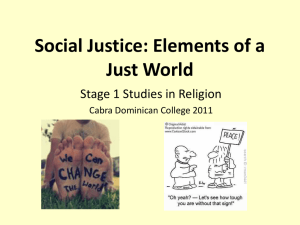

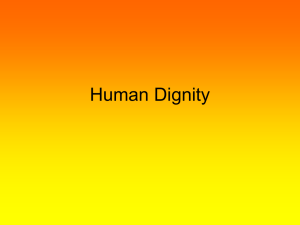


![4[1]._a_man_as_a_person](http://s2.studylib.net/store/data/005226893_1-b67b2be2c3623c1c44b6baa80b997c62-300x300.png)

